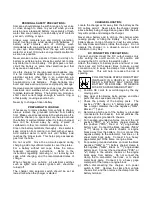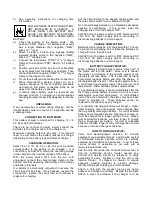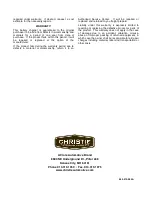
h)
See operating instructions for charging time
information.
FOLLOW
THESE
STEPS
FOR
BATTERY
NOT
INSTALLED
IN
A
VEHICLE.
A
SPARK
NEAR
THE
BATTERY
MAY
CAUSE
THE
BATTERY
TO
EXPLODE.
TO
REDUCE
RISK
OF
A
SPARK
NEAR
BATTERY:
a)
Check the polarity of the battery posts. The
positive ("POS", Red or "
+
") battery post usually
has a larger diameter than negative ("NEG",
Black or "
-
") post.
b)
Attach at least a 24-inch long 6-gauge (AWG)
insulated battery cable to the negative ("NEG",
Black or "
-
") battery post.
c)
Connect the red positive ("POS", or "
+
") charger
clamp to the positive ("POS", Red or "
+
") battery
post.
d)
Position yourself and the free end of cable (Step
b) as far away from the battery as possible. Then
connect the black negative ("NEG" or "
-
") charger
clamp to the free end of cable.
e)
Do not face battery when making final connection.
f)
When disconnecting charger, always do so in
reverse sequence of the connecting procedure
and remove first clamp connection while as far
away from the battery as possible.
g)
A marine (boat) battery must be removed and
charged on shore. To charge it on board requires
charging equipment specially designed for marine
use.
UNPACKING:
If any damage has occurred during shipping, call the
transportation carrier at once for an inspection and file
a damage claim.
CONNECTING TO BATTERIES:
This battery charger is designed for charging 12, 18,
24, 32 or 36 Volt batteries.
There are no controls to adjust, simply connect the
batteries to the charger and turn the charger on.
Maximum charging output is 25 amps. This rate will
taper to a low rate as the battery reaches full charge,
depending on the battery type and state of charge.
CHARGING OPERATION:
Select the 12, 18, 24, 32 or 36 Volt switch position
corresponding to the battery to be charged – It is
critical that you ALWAYS match the operating voltage
of the charger to the nominal voltage of the battery.
With the power switch OFF and the AC cord
unplugged, connect the charging lead clamps to the
battery, carefully observing the polarity of the clamps
and battery terminals.
If a battery is accidentally connected in reverse, the
circuit fuse will be blown. If this happens, reverse the
connections, replace the circuit fuse and continue to
prepare for charging.
Set the Timer Switch to the desired charging time and
the rate control switch to Low, Medium or High.
Do not overcharge batteries, as indicated by excessive
gassing or overheating. If this occurs, lower the
charging rate or turn the charger OFF.
ALWAYS turn the power switch to OFF disconnect AC
cord from AC power supply before connecting or
disconnecting batteries to avoid a spark.
CHARGE COMPLETION:
Batteries will normally be fully charged within 12 hours.
To prevent overcharging, do not leave the batteries on
charge for more than 24 hours.
ALWAYS turn the power switch to OFF disconnect AC
cord from AC power supply before connecting or
disconnecting batteries to avoid a spark.
BATTERY CHARACTERISTICS:
When a battery is being charged, acid is "driven out" of
the plates and into the water. Since acid is heavier
than water, an increase in the specific gravity of the
electrolyte will take place. This is observed by taking
hydrometer readings before and after the charge. A
discharged battery reads 1.150 specific gravity or less.
A full charged new battery reads 1.265 when at room
temperature. Older batteries will be somewhat less.
If a hydrometer reading is taken immediately after the
fast charge (while battery is warm) be sure to use a
temperature corrected hydrometer. In old batteries,
part of the active material in the plates may have been
"shed" or dropped off. These batteries cannot be
restored to full capacity by any charger.
A completely discharged battery will accept a higher
initial charging rate and requires more charging time
than a partially discharged battery. A cold or sulfated
battery will not readily accept a high rate of charge, so
must be charged for a longer period of time. Heavy-
duty commercial batteries will take longer to charge
than a passenger car battery. All cold or sulphated
batteries will take longer to fully recharge than normal
because of reduced charge acceptance.
HOW TO OBTAIN SERVICE:
Parts and warranty/repair services for Christie
equipment are available through a nationwide system
of Authorized Service Centers, which are carefully
selected by Christie/Clore Automotive. A list of these
service centers is available on our web site at
www.cloreautomotive.com.
Use the web site (under the Technical Service tab) to
find the Authorized Service Center nearest you.
Contact the Service Center by telephone to verify
availability of parts. Deliver or ship the unit to the
Service Center. If shipped, be careful to provide
adequate packing material to prevent damage.
Identify with proper shipping and return address.
Attach a note with the product, giving your name,
address and telephone number. Explain the problem.
Attach a proof of purchase if the charger is to be




